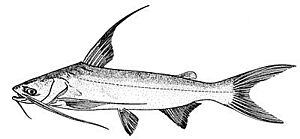Gafftopsail catfish facts for kids
Quick facts for kids Gafftopsail catfish |
|
|---|---|
 |
|
| Conservation status | |
| Scientific classification | |
| Genus: |
Bagre
|
| Species: |
marinus
|
| Synonyms | |
|
|
The gafftopsail catfish (Bagre marinus) is a type of fish that lives in the ocean. You can find it in the western Atlantic Ocean, the Gulf of Mexico, and the Caribbean Sea. This fish has long, pointy spines that can be painful if they poke you. It mostly eats small sea creatures like crabs and shrimp, but also other fish.
One cool thing about gafftopsail catfish is how they raise their young. The male fish keeps the eggs safe in his mouth until they hatch! These fish are often caught by people fishing in the Southeastern United States. They are known for being strong fighters when caught. People catch them from piers, jetties, or even from the beach. They use different baits like shrimp or special lures.
Contents
Where Gafftopsail Catfish Live
Gafftopsail catfish are found along the coasts of the Atlantic, Caribbean, and Gulf of Mexico. Their range stretches from Cape Cod all the way down to Brazil.
They can also live in brackish water. This is water that is a mix of fresh and saltwater. You might find them in places like estuaries (where rivers meet the sea), lagoons, or mangroves. These catfish are usually quite common in the areas where they live.
What Gafftopsail Catfish Look Like
The gafftopsail catfish is usually blue-grey or dark brown on top. Its belly is a lighter grey color. It looks like a typical catfish, but it has a tail that is deeply forked, almost like a swallow's tail. Be careful, because it also has sharp, venomous spines. It has a small hump on its back that looks a bit like a wave.
A grown gafftopsail catfish is usually about 43 cm (17 in) long. It has a fin near its tail called the anal fin, which is white or pale blue. This fin has 22 to 28 soft rays. It also has long whiskers, called barbels, around its mouth and chin. These help it find food. The gafftopsail catfish looks a lot like another fish called the hardhead catfish. But the gafftopsail has a special fleshy part on its top fin, which looks like a ship's sail. This is how it got its name!
What Gafftopsail Catfish Eat
Unlike many other catfish that stay near the bottom, gafftopsail catfish hunt for food all through the water. They mostly eat crustaceans, which are creatures with hard shells. This includes crabs, shrimp, and prawns, making up about 95% of their diet. They will also eat worms, other small invertebrates, and bony fish.
When they are young, gafftopsail catfish mostly eat tiny bits of organic matter. As they grow, fish become their second most important food. Besides humans, big sharks like the tiger shark and bull shark also hunt gafftopsail catfish.
Reproduction and Life Cycle
Gafftopsail catfish lay their eggs in shallow, muddy areas near the coast. This happens during a short time, usually from May to August. They are known as "mouthbreeders." This means the male fish carries the eggs in his mouth!
The eggs are quite large, about 2.5 cm (1 in) across. A male catfish can hold up to 55 eggs in his mouth until they hatch. When the young fish hatch, they are about 5 cm (2 in) long. The male might keep them in his mouth until they are even bigger, up to 10 cm (4 in) long. While the male is carrying the eggs or young fish, he does not eat anything. This helps keep the babies safe.
Fishing for Gafftopsail Catfish
Gafftopsail catfish are a popular fish to catch in the Southeastern United States. You can also find them as far north as New York. People catch them from many different spots, like piers, jetties, and reefs. They also fish for them from the beach or in shallow water.
Fishermen use various baits and lures to catch them. Common baits include cut pieces of fish or shrimp. They also use artificial lures that look like shrimp, worms, or small fish. Sometimes, fishermen use special floats that make a popping sound. This sound can attract the catfish because it sounds like a struggling fish.
It's important to be careful when handling gafftopsail catfish because of their venomous spines. If you catch one, make sure you know how to handle it safely to avoid getting poked.
Images for kids



